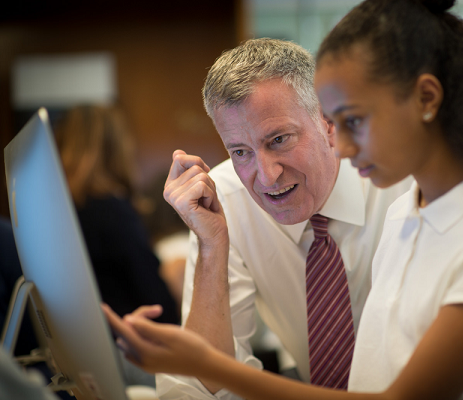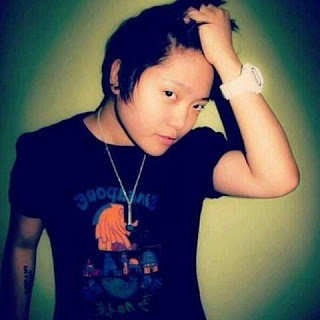Debate on admissions to Specialized High Schools: FilAms share views

For FREE immigration consultation, CLICK HERE. Use Code: THE FILAM

Mayor Bill de Blasio unveiled his ‘Computer Science for All’ initiative in 2016 in this photo taken in the Bronx. Photo by Michael Appleton/Mayoral Photography Office
By Reese Villazor
New York City has some of the best public high schools in the United States. Among these are the eight specialized high schools, which include Brooklyn Tech, Bronx Science, and Stuyvesant. Gaining admission to these schools is earned only through the Specialized High Schools Admissions Test (SHSAT) which is a very competitive process.
Recently, Mayor Bill De Blasio proposed eliminating the SHSAT and adopting a new method for gaining admission to the specialized high schools. As I was reading about the issue, I wondered about Filipino Americans enrolled in such schools.
In years past, the results of the most recent SHSAT show the test’s high level of difficulty. In 2018, only about 18 percent, about 510 of the 28,333 students who took the SHSAT received offers from specialized high schools. Also, as in past years, those who received offers to the specialized high schools were primarily Asians and Whites. Black and Latino students received few offers.
In the New York City public schools, Asian Americans make up 16 percent of students, Whites 15 percent, Blacks 26 percent, and 40.5 percent are Latino. However, broken down into the percent of testers who received offers of admission, by ethnicity, the results were as follows: Asians received around 29.7 percent of the spots they applied for, Whites 26.5 percent, Blacks 6.3 percent, and Latinos 4.1 percent. Out of the total students who received offers, 51.7 percent were Asian, a number that is influenced by Asians being the largest ethnic group to take the test.
Because of this racial imbalance, Mayor De Blasio has proposed a series of changes in the admissions process. These changes will include phasing out admission through the SHSAT and increasing the spots set aside for students from private and parochial schools. In addition, he wants to expand the Discovery Program, a summer program that currently admits low-income students with SHSAT scores just below the cut-off into specialized high schools.
The proposal to phase out the SHSAT has been met with mixed responses. Some are worried that changing the structure of entrance exams is not logical, as they believe the SHSAT to be an apt measurement for determining access. Others are concerned the method will not properly address the underrepresentation of Black and Latinos students.
As one enrolled in a specialized school, I know from experience that the category of “Asian” is not only extremely broad, but also leaves out the diversity of Asians. The lack of statistics concerning Filipino Americans intrigued me to investigate the topic. I wanted to learn what my fellow Filipino students thought of De Blasio’s proposal.
I surveyed six Filipino American students and alumni. The alumni went onto highly ranked colleges, and their professions range from lawyers to aspiring environmentalists. I got varying responses as expected. Some thought the SHSAT was fair and “unbiased” and a good approach for determining entry. Also, they believed the test was not discriminatory, because everyone has the opportunity to take it. Furthermore, others thought that the SHSAT was an accurate measurement of one’s intellectual ability because it tests the subjects one takes in school.
However, others thought the SHSAT was not a good approach. Some thought one can do well on the SHSAT by preparing for the test itself through mastering test-taking strategies and taking preparatory courses. This would provide an advantage to those who have money or resources or have access to these preparatory courses.
For the most part, the individuals disagreed with De Blasio’s proposal. Some believed that by changing the system to allow entrance to the top ranked students at middle schools would narrow the opportunity for Asian American students to gain entry. Others thought that the proposal would not be effective because it is not “standardized,” meaning it would accept top ranked students from every middle school, regardless of the focus or the condition of the school.
I believe that schools should be representative of the diversity within New York City, and if the current system allows for a disadvantage of some minorities, then it should be changed to allow for equal opportunities to gain entrance into the school that one wants.
The majority of the individuals that I surveyed did share my perspective on this, although a few did not think diversity was an issue. One of these few believed that ethnicity did not have any influence in how students got in through the test, so the current demographic of the specialized high schools was not deliberate.
For the most part, however, the individuals had a similar opinion to myself on diversity. One who was particularly passionate stated, “As someone who believes in diversity and inclusion, I don’t think we can be in a city that calls itself a melting pot and have high schools that are fairly segregated, even if I benefited from that.”
Despite some disagreements, there was a consensus that the underrepresentation of Blacks and Latinos in specialized high schools is an important issue that should be acknowledged and changed.
While I conducted the survey, I learned about some riveting experiences in the specialized high schools. For instance, one former student felt isolated by the lack of Filipinos within the schools and felt conflicted in their ethnic identity. This student used poetry as an outlet for this isolation. In addition, another former student felt as if they had missed out on other opportunities that came with the “American high school experience.” They were very focused on their grades, and felt the pressure to always succeed on every test.
Reese Villazor is a sophomore at the Bronx High School of Science. She is passionate about social justice and equal rights. She is on the Mock Trial team and participates in Speech and Debate.











